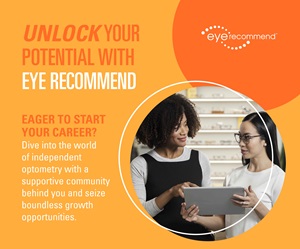
In optical retail, customers don’t walk in asking for better lenses—they come in looking for glasses. The frame, the style, the image—that’s what drives their decision-making. In this episode of Revenue RX: Optical Retail Wins, I explore a crucial distinction: the difference between a need-based sale and a want-based sale.
Selling a pair of glasses isn’t just about filling a prescription—it’s about fulfilling a desire. When you tap into the customer’s want, you create a deeper connection, improve customer retention, and ultimately drive more revenue. The challenge? Most customers don’t even know what they want until you help them discover it.

Selling What Customers Want vs. What They Need
Most opticians focus on the need-based sale—the prescription, the medical necessity. But that’s only half of the equation. The real opportunity comes from the want-based sale—helping customers find a frame that speaks to their personality, lifestyle, and self-image.
Think about it: customers don’t ask for “anti-reflective coating” or “high-index lenses.” They walk in saying, I need new glasses. They assume the lenses will do their job; what they truly care about is how they look and feel in their frames.
When you focus on the want, customer retention and increased revenue naturally follow.
How to Discover the Customer’s Want
The key to unlocking what the customer truly wants isn’t asking, How can I help you? Instead, try something different:
👉 “Here, put this frame on. Tell me what you see.”
This approach does two things:
- It gets the customer talking—not just about the product but about how they feel wearing it.
- It separates you from the competition, making the experience more interactive and personal.
Engaging in a real conversation, rather than just guiding them to a sale, helps customers discover what they want—not just what you think looks good on them.
The Role of Image in Optical Retail
Optical retail is more than just vision—it’s about image. Every customer wants to project a certain look. Do they want to appear sophisticated? Trendy? Professional? Approachable? The frames they choose help shape that perception.
Many purchases aren’t driven by logic alone. Prestige, status, and emotion play a huge role. Rather than looking for the best deal, customers are drawn to products that make them feel good. Understanding this mindset is critical when selecting inventory—your staff, not just your suppliers, should play a role in deciding which frames to carry. After all, they know the customers best.
The Difference Between Customer Service and Serving the Customer
Many businesses focus on customer service, which is often reactive—handling complaints, processing returns, or answering questions. But serving the customer is proactive and built around understanding and anticipating their needs.
✔️ Customer service: Helping with an issue, answering questions, processing a transaction.
✔️ Serving the customer: Building a relationship, personalizing recommendations, making them feel valued beyond the sale.
True service is about putting the customer’s best interests first, creating an experience where they feel seen, heard, and appreciated—not just sold to.
How to Build Lasting Customer Loyalty
Customers don’t like being sold to, but they love being served. That’s why it’s important to turn on service mode the moment someone walks into your store. Customers don’t see themselves as a transaction—they’re looking for a solution, a better image, a better experience.
When you focus on service, not selling, the sale becomes the byproduct of a great experience.
✔️ Instead of saying, How can I help you?
➡️ Say, How can I serve you?
This simple shift changes the tone of the conversation and sets the expectation that the customer is in for a personalized, thoughtful experience—not a hard sell.
Inspiration vs. Manipulation: The Key to Long-Term Success
Many businesses rely on manipulative marketing tactics—flash sales, BOGO deals, heavy discounts—to drive short-term sales. While effective in the moment, this approach doesn’t build loyal customers.
Inspiration, not manipulation, breeds long-term success.
✅ Customers who are manipulated by deals will leave for a better deal.
✅ Customers who are inspired by their experience will return again and again.
Instead of competing on price, focus on value—the experience, the service, and the personal touch that makes customers want to come back.
Final Thoughts: The Revenue RX Formula for Customer Connection
Success in optical retail isn’t about simply selling glasses—it’s about:
✔️ Understanding the difference between need and want
✔️ Helping customers discover what they truly desire
✔️ Moving beyond customer service to serving the customer
✔️ Creating lasting loyalty through inspiration, not manipulation
Customers don’t just buy glasses—they buy confidence, self-expression, and trust. The more you focus on their want, the more successful your business will be.
Want to learn more? Tune in to this episode of Revenue RX: Optical Retail Wins and discover how customer connection can transform your bottom line. And don’t miss the next episode, where we explore how to stop selling glasses and start making money!

Joseph Mireault
Joseph Mireault, Optical Entrepreneur, Business Coach, and Published Author.
Joseph was the owner and president at Tru-Valu Optical and EyeWorx for 16 years. During his tenure, he consistently generated a sustainable $500K in annual gross revenue from the dispensary.
He now focuses on the Optical industry, and as a serial entrepreneur brings extensive experience from a variety of different ventures.
Joseph is also a Certified FocalPoint Business Coach and looks to work directly with ECPs in achieving their goals.
Through his current endeavour, the (Revenue RX, Optical Retail Wins podcast) he shares the challenges and solutions of running an Optical business.
His insights are shared with optical business owners aspiring for greater success in his new book, “An Entrepreneur’s Eye Care Odyssey: The Path to Optical Retail Success.”











